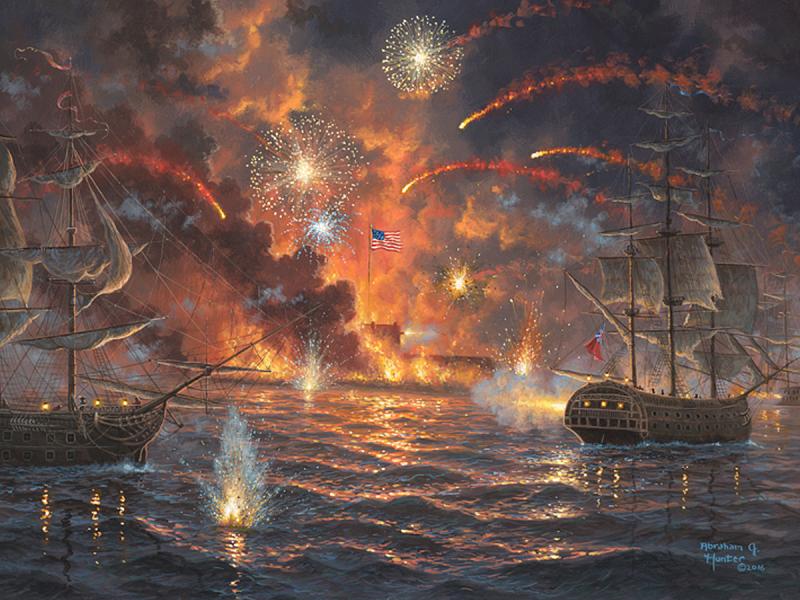A short but exciting history of fireworks in Lewes

The first real public display of fireworks in Lewes came in April 1813. That's when the British bombarded the town from the cannons of the HMS Poictiers sitting offshore in Delaware Bay as part of a blockading fleet. The commodore didn't like the citizens' refusal of a demand for food and drink and whatever else the townspeople could rustle up.
In an early display of American ingenuity, members of the Delaware militia gathered up the king's cannonballs that missed their mark, loaded them into their own cannons, and sent them flying back at the ship.
The British didn't like that either. For all their trouble, they damaged little in the town before sailing off to Rehoboth - unsettled at the time - to fill their empty water casks from the freshwater of Silver Lake. Again they were thwarted.
The militiamen, who had come to Lewes' aid, hightailed it down the coast and met the redcoats with more of the hot stuff and ran them away, their throats still dry.
The real fireworks in that bombardment, however, figure in our national anthem written by Francis Scott Key from a ship in Baltimore harbor when the British were bombing Fort McHenry in 1814. The new technology terror weapons in that war were ship-launched rockets called Congreves. Rather than just a heavy iron ball blasted from a cannon, the Congreves were actual gunpowder-propelled rockets that carried an exploding charge toward their targets. They had been tested a year before in Lewes where they brought about as much success as they did at Fort McHenry. But they did inspire the line in Key's song that says: "And the rockets' red glare, the bombs bursting in air, gave proof through the night, that our flag was still there."
I didn't have to write that last part about giving proof, but it's such a great visual and it gives me goosebumps. (See painting.)
So in Lewes, there's still a cannonball in the foundation of the Cannonball House on Front Street, and cannons in 1812 Memorial Park, but little more to remind us of that first fireworks display. Shortly after, some local writer recorded the damage inflicted by the British on Lewes with a little poem that goes something like: "The admiral and all his men wounded a pig and killed a hen."
Fireworks in the Stango era
Dial forward about 163 years to 1976 when the nation was celebrating its 200th anniversary. Al Stango was mayor, Ronnie Donovan was city manager and Hucky Hudson presided over the Board of Public Works. Between the three of them, they constituted their self-appointed Lewes Special Events Committee and arranged for the Delaware Cape Region's only July Fourth fireworks show.
Working with Jack Goins, who was superintendent of Cape Henlopen State Park, they contracted for a show to be launched out over the ocean from the dunes. They spread the word, and on the night of the show they stood at the entrance to the park and collected $10 per vehicle from the hundreds of carloads of people who showed up for the event.
It was a great success, but in subsequent years, unpredictable weather and errant fireworks lighting little fires in the dunes brought that chapter of public fireworks to a close.
In the intervening years, private citizens filled the void with their own July Fourth fireworks displays up and down Lewes Beach. Town officials, feeling that patriotism trumped a minor question of legality, turned a blind eye.
One year, family and friends headed out on the good ship Gloria to watch the display. The fireworks ended, but not the fire.
A wind shift to the north sent a few rockets into the marsh between the houses on Lewes Beach and the canal. Mats and mats of dead marsh grass kindled quickly and it looked to all of us that the British were finally having success with burning down the town.
Fortunately, the well-trained volunteers of the fire department were able to contain the fire to the marsh in the area of the dredge spoils site with little more damage than the commodore had wrought.
And now we're coming up on the July 4, 2018 celebration. This time it's not a commodore's but rather a fire marshal's threats that are bringing back a public fireworks display.
Town officials were told last year that if they did not enforce state laws against private fireworks displays, and there were injuries, they could be held personally liable. Such liability would probably cost more than the few bullocks, baskets of vegetables, and casks of water that Commodore Beresford had demanded.
As a result, a committee headed up by Russ Palmer went to work to raise funds for a publicly funded and sanctioned show.
At dusk, there will be a 12- to 15-minute display launched from Delaware Bay, probably not far from where the Poictiers launched its Congreve rockets 205 years ago.
About 1,500 feet off the public beach, a fireworks-loaded barge running a falling tide out of Chester, Pa., will be anchored for the display.
Since the public beach at Lewes is just about in the center of a big semicircle defined by Roosevelt Inlet to the west and the point of Cape Henlopen to the east, it should make for an amphitheater-style performance if the weather gods smile on the town.
Mayor Ted Becker said the smaller rockets will light up the sky from 150 feet up while the larger ones will soar up to 800 feet before bursting a shower of color over Breakwater Harbor.
And that will come on the heels of Rehoboth's display scheduled for this Sunday night, unless the ghosts of the Delaware militia head south one more time and chase the Zambelli folks off the beach there.
Pretty exciting, huh?























































